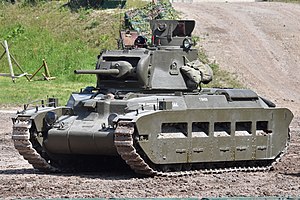
Back Matilda II Afrikaans Мацільда (танк) Byelorussian Матилда (танк) Bulgarian Matilda II BS Tanc Matilda Catalan Matilda Mk II Czech Matilda (kampvogn) Danish Matilda (Panzer) German Matilda (tanko) Esperanto Matilda II Spanish
| Infantry Tank Mark II | |
|---|---|
 A Matilda II on display at TankFest 2019 | |
| Type | Infantry tank |
| Place of origin | United Kingdom |
| Service history | |
| In service | 1939–1955 |
| Used by | United Kingdom Australia Soviet Union Nazi Germany (captured) Egypt |
| Wars | Second World War 1948 Arab–Israeli War |
| Production history | |
| Designer | Mechanization Board and Vulcan Foundry |
| Designed | 1937[1] |
| Manufacturer | Vulcan Foundry and others |
| Produced | 1937–1943 |
| No. built | 2,987 |
| Variants | see Variants below |
| Specifications | |
| Mass | 25 tons[2] |
| Length | 18 ft 5 in (5.61 m)[3] |
| Width | 8 ft 6 in (2.59 m)[4] |
| Height | 8 ft 3 in (2.51 m) |
| Crew | 4 (driver, gunner, loader, commander)[4] |
| Armour | 20 to 78 mm (0.79 to 3.07 in)[4] |
Main armament | QF-2 pounder (40 mm) gun, 93 armour-piercing rounds[5] |
Secondary armament | 7.92 mm Besa machine gun 2,925 rounds[5] |
| Engine | 2×diesel 6-cylinder 7-litre engines: 2×AEC[a][5] or 2×Leyland[2] 190 bhp (140 kW) Leyland engine[6] |
| Power/weight | 7.5 bhp (5.6 kW) / tonne |
| Transmission | 6 speed Wilson epicyclic pre-selector gearbox |
| Suspension | Coil spring[2] |
| Fuel capacity | 40.0 imperial gallons (181.8 L) Internal + 35.9 imperial gallons (163.3 L) auxiliary tank [7] |
Operational range | 80 kilometres (50 mi) With Internal + 157 kilometres (98 mi)with auxiliary tank [7] |
| Maximum speed | 15 mph (24 km/h) Mk III on road [7] 9 miles per hour (14 km/h) off-road |
Steering system | Rackham clutches[8] |
The Infantry Tank Mark II, better known as the Matilda, is a British infantry tank of the Second World War.[1]
The design began as the A12 specification in 1936, as a gun-armed counterpart to the first British infantry tank, the machine gun armed, two-man A11 Infantry Tank Mark I. The Mark I was also known as Matilda, and the larger A12 was initially known as the Matilda II or Matilda senior. The Mark I was abandoned in 1940, and from then on the A12 was almost always known simply as "the Matilda".
With its heavy armour, the Matilda II was an excellent infantry support tank but with somewhat limited speed and armament. It was the only British tank to serve from the start of the war to its end, although it is particularly associated with the North Africa Campaign. Only two were available for service by the outbreak of World War II in 1939.[9] It was replaced in front-line service by the lighter and less costly Infantry Tank Mk III Valentine beginning in late 1941.
- ^ a b Jentz, p. 11.
- ^ a b c Jentz, p. 13.
- ^ Boyd (2008).
- ^ a b c Bean & Fowler (2002), pp. 147–148.
- ^ a b c Jentz (1998), p. 12.
- ^ Jentz (1998), pp. 12–13.[verification needed]
- ^ a b c Fletcher (1994), p. 28.
- ^ Fletcher (1994), p. 6.
- ^ Tank Chats #19 Matilda II. The Tank Museum. 28 April 2016. Retrieved 7 December 2020 – via YouTube.
Cite error: There are <ref group=lower-alpha> tags or {{efn}} templates on this page, but the references will not show without a {{reflist|group=lower-alpha}} template or {{notelist}} template (see the help page).
© MMXXIII Rich X Search. We shall prevail. All rights reserved. Rich X Search